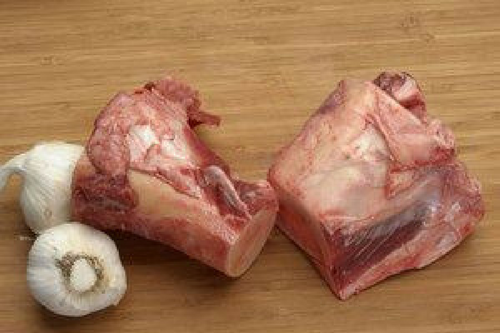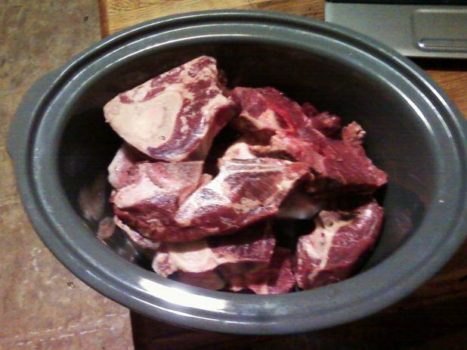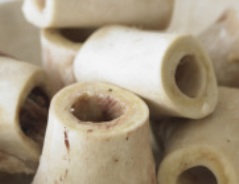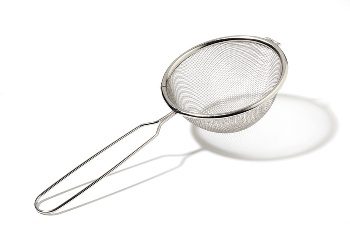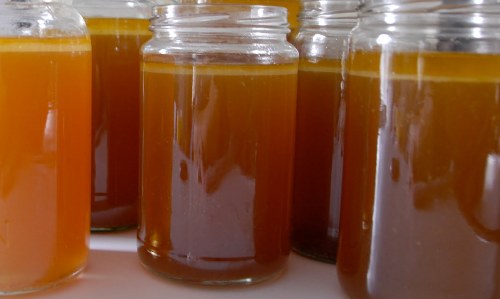How to Make Nourishing Beef Bone Broth to Heal Your Gut
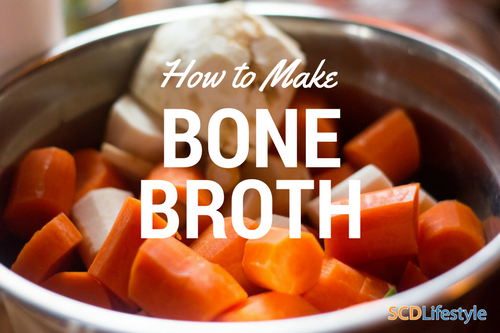
Homemade bone broth can help repair your gut and restore your healthy mucosal lining. Not only that, but bone broth is chocked full of collagen, gelatin, glycine, and proline (great article about their benefits here).
Last but not least, bone broth also contains glutamine, an important fuel for intestinal cells that may help repair a leaky gut (study). I drink 8-12 oz in a coffee mug every single morning and I’ve really found it helps, especially when I’m trying to manage heavy stress or running low on sleep. Not only that, but it was the only thing that brought me back to life during my latest bout with the stomach flu…
In this post, I’m going to show you how to make a basic beef bone broth to help you heal your gut (and what to do if you don’t want to make it at home).
Beef Bone Broth Step 1:
Find a source for your beef bones. I typically mix two types of beef bones when I make bone broth. I use “Beef Marrow Bones” like these from U.S. Wellness Meats:
For the best healing effects, find a source that uses certified Grass Fed Cows. (For extra credit, grab some knuckle to throw in the pot as well).
You can buy bones and knuckle from a source like U.S. Wellness Meats or your local butcher. Local farmers that raise Grass Fed Cows will also be able to tell you which butcher they typically take their cows to and you can source it from there.
I like to make beef bone broth in a slow cooker, which fits about 5 pounds of bones. So, I use about 2.5 pounds of “Marrow Bones” and 2.5 pounds of “Beef Soup Bones.”
Beef Bone Broth Step 2:
Add all 5 pounds of bones into a slow cooker.
Don’t forget to add either a few shots of apple cider vinegar OR the juice from one lemon. They provide acids that help extract more nutrients from the bones.
Next, fill the slow cooker with water (preferably filtered) and set it for 24 hours on low heat.
HOT TIP: Sometimes the smell can bother family/friends/pets (ha-ha). Lately, I’ve actually been setting this out in my garage to cook so I don’t have to fill my house with bone broth scent (it’s currently winter in Michigan).
Beef Bone Broth Step 3:
After the bones have been cooking for 24 hours, you can add in a few veggies for flavor. You won’t be eating these, so don’t bother peeling them or cutting off the stems:
- Carrots
- Celery Stalks
- Sweet Onion
- 2 Tablespoons Parsley
- 2 Tablespoons Sea Salt
- 2 Tablespoons Black Pepper
Then, set it for another 12 hours or so… but timing is completely up to you. The longer you cook it on low the more the bones will break down and release nutrients into the broth.
Beef Bone Broth Step 4:
After about 30 hours, check the marrow bones to make sure the marrow has fallen out of the bone. Sometimes I have to pick out the bones with tongs and use a fork to knock the marrow out of the center.
Beef Bone Broth Step 5:
Once the bones have been slow cooking for 36 hours, turn off the slow cooker and let it cool down naturally for a few hours. Then, I will usually skim off the big stuff like the veggies and give them to the dogs. I have heard you can use the meat and veggies to make good soup but I haven’t tried it yet.
The next step is to drain the broth through a mesh colander like this one:
It’s important to ask the question: how am I going to store this broth?
I’ve heard mixed information on how long beef bone broth lasts in the refrigerator, so I’ve been sticking to a week or so. Keep that in mind when you store it. I like to drink about 8-12oz every morning so I need about 70 ounces to last me 7-days.
Glass storage is always a better way to go than plastic… but as you drain the broth through the colander you’ll want to pour it right into the container you choose. I like to store mine in glass mason jars like these:
Freeze what you’re not using and try to drink some every day.
It’s also a great stock to cook with. Enjoy!
What To Do If You Can’t Make Your Own Bone Broth
There are a few reasons why you might not want to make broth at home:
- You don’t have easy access to high quality bones
- You don’t have access to a kitchen or the tools you’ll need
- You’re really busy and just don’t have time to make broth all the time
All of those situations have applied to me at one time or another, too.
Bone broth used to be exclusively homemade – but in the last year the sale of packaged broths has skyrocketed.
This is good and bad – good because it means this powerful food is more accessible than ever. But the bad new is that not all packaged bone broths are comparable to homemade.
(A good trick is to check the protein content of any bone broth you’re considering buying – regular broth has little to no protein – a true bone broth has much more protein per serving!)
We’ve tried a lot of bone broths, and the only brand we recommend now is Kettle & Fire.
Here’s why:
- It is made from 100% grass fed beef bones and vegetables (and never frozen)
- Has extremely high amounts of collagen, glycine and amino acids which improve digestion
- Slow-simmered so that protein and nutrients are extracted from the bones (like I make it at home)
- Shelf-stable (in safe, non-toxic packaging) so I can keep it in my pantry, travel with it, and always have it on hand
- Actually tastes really good
The folks at Kettle & Fire spent more than a year tweaking their recipe, finding sustainable and organic sources for all the ingredients, and perfecting a unique packaging system that keeps it fresh for up to 2 years in your pantry.
If it isn’t homemade bone broth, Kettle & Fire is what I’m drinking.
P.S. – Leave any cool modifications you try in the comments below. Experiment away!
Did You Like this Article?
Subscribe to our newsletter to receive email notifications, some ways to find relief, and next steps.

